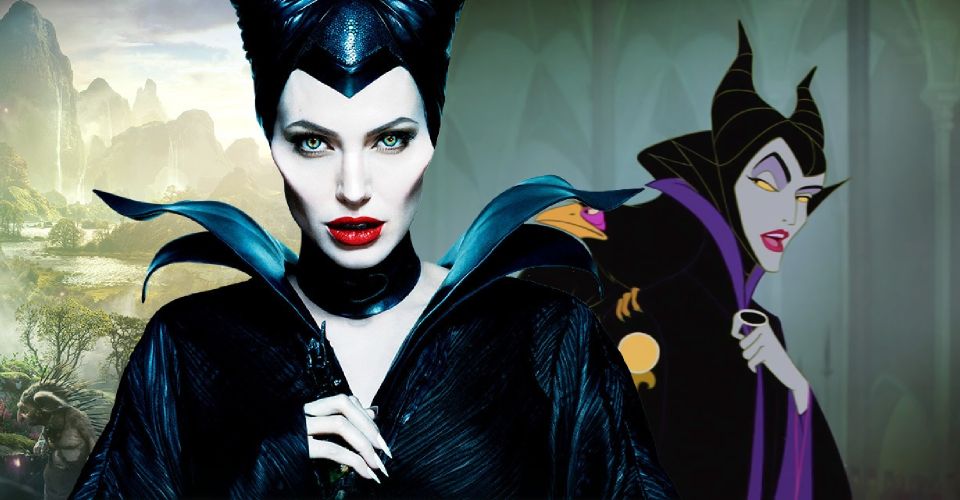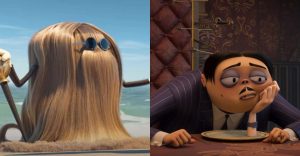Maleficent: How The Live-Action Evil Queen Is Different To The Animation

Maleficent, the 2014 live-action reimagining of Sleeping Beauty, transforms the Mistress of Evil into a much more sympathetic character and makes major changes to her personality and backstory. Starring Angelina Jolie as Maleficent and Elle Fanning as Aurora, Maleficent and its sequel Maleficent: Mistress of Evil detail the dark fairy’s backstory: from her early relationship with the future King Stefan to her complicated one with Aurora. Maleficent is a stunning reinterpretation of the classic fairytale villain that turns her into a nuanced and good-hearted fairy facing off against Stefan’s corrupt kingdom.
Disney’s 1959 animated film Sleeping Beauty tells the story of Princess Aurora, who is cursed by the evil fairy Maleficent into falling into an enchanted slumber that can only be ended with true love’s kiss. Sleeping Beauty was part of Disney’s unexpected fairy-tale trend and followed up Snow White and the Seven Dwarves. Maleficent curses Aurora as retribution for not being invited to the princess’s christening, and the titular villain is fairly straightforward, with no obvious connection to Aurora and her parents. The 2014 film Maleficent, and the 2019 sequel Maleficent: Mistress of Evil, make Maleficent the center of the story instead of Aurora and turns her into a layered, complicated woman. In doing so, the movie makes many changes to Maleficent’s character, including changing her backstory, her personality, and her relationship with Stefan.
Some of the changes Maleficent makes to Sleeping Beauty are small, like getting rid of Prince Phillip’s father King Hubert; some are large, like introducing the neighboring fairy kingdom called the Moors. But most of the changes in Maleficent have to do with the Mistress of Evil herself.
Maleficent & Her Wings

Maleficent first introduces the dark fairy when she’s still a young girl. Maleficent is a fairy living in the Moors, and has a massive pair of wings that she uses to fly. Fans of the classic Disney princess movie Sleeping Beauty will know that Maleficent never had wings in the original animated film, and Maleficent explains how the dark fairy lost her wings. After Maleficent killed the corrupt King Henry, who was trying to invade the Moors with a human army, he offered his throne to any man who would kill her. Stefan, Maleficent’s childhood friend and first love, tricks the fairy into drinking a sleeping potion and uses iron to burn her wings off, bringing them back to King Henry and claiming the throne.
The trauma stemming from the loss of her wings are a major part of Maleficent and a significant departure from the animated movie. Maleficent’s anger at Stefan and desire for revenge is what prompts her to curse Princess Aurora — not the petty grievance of not being invited to the christening. Losing her wings gives Maleficent a reason for the curse, and turns her into a more complicated figure than the more traditional Disney villain she is in Sleeping Beauty. While Maleficent’s hatred of Stefan in Sleeping Beauty is part of her broader vendetta against humans, Maleficent re-contextualizes her rage as a response to her personal trauma.
Stefan & Maleficent’s Love Story

If King Stefan and Maleficent have a prior relationship in Sleeping Beauty, the movie never shows it. Maleficent is portrayed as an evil fairy terrorizing Stefan’s kingdom — but one who has no real connection to the royal family. Maleficent makes a major departure from the animated film by turning Stefan and Maleficent into childhood friends, and later into each other’s first love. When Stefan eventually betrays Maleficent and takes her wings, it makes her pain even more acute — and gives Maleficent even more reason to seek revenge and curse Aurora.
Maleficent’s childhood relationship with Stefan also turns her into a softer and more grounded character, instead of the campy over-the-top villainousness that she shows in Sleeping Beauty. When Stefan kisses Maleficent as teenagers, he calls it true love’s kiss — and following his betrayal, both characters stop believing in true love. When Maleficent creates Aurora’s curse, it’s clearly designed to cause Stefan as much pain as possible; designing the curse to only be broken with true love’s kiss, something that neither of them believe is real, is a particularly painful touch in Maleficent that just seems like basic fairytale fare in Sleeping Beauty.
Mistress of Evil vs. Protector of the Moors

In Sleeping Beauty, Maleficent proclaims herself the Mistress of Evil. It’s a reputation that she’s earned after responding to King Stefan’s snub by cursing Aurora with an eternal sleep (like the fairy-tale) and terrorizing his kingdom for no real reason. Maleficent is sometimes incorrectly referred to as an evil queen, likely because she lives in an abandoned castle in the Forbidden mountains, but she isn’t actually a queen in Maleficent or in Sleeping Beauty (in Maleficent her aunt and uncle were technically rulers of the Moors, although that was cut from the final film.) Instead, Maleficent is Protector of the Moors, the neighboring fairy kingdom she calls him.
Maleficent is still called the Mistress of Evil in Maleficent by Stefan and his subjects after she killed King Henry. However, she’s much more focused on protecting her own, peaceful people from Stefan’s corrupt kingdom than she is on terrorizing humans. She only has to assume the position of Protector when the humans attacked the Moors unprovoked, and Maleficent was forced to fight back, turning the Moors into a cursed kingdom in the process and surrounding it with a thick wall of thorns.
Aurora and Maleficent

The biggest difference that Maleficent makes to the titular character is the relationship between Maleficent and Aurora. In Maleficent, their relationship begins with Maleficent curses Aurora as revenge for Stefan’s betrayal, but starts growing fond of the princess the older that she gets. With three careless fairies watching over Aurora, Maleficent finds herself having to step in and keep her safe so Aurora turns 16 and her curse will be fulfilled. Aurora realizes that someone is watching over and and mistakes Maleficent for a fairy godmother, and the pair become extremely close.
In Sleeping Beauty, Maleficent and Aurora don’t have a relationship at all. After cursing her as a baby, Maleficent only sees Aurora again when she pricks her finger, but they never communicate with each other. In Maleficent, they grow so close that it’s Maleficent who breaks Aurora’s curse with true love’s kiss, when she kisses the sleeping princess on the forehead. In return, Aurora is the one who frees Maleficent’s wings when she’s about to be killed by Stefan. Their maternal relationship is a big difference from Sleeping Beauty, but it ultimately makes Maleficent a much better movie.
Maleficent is a very different interpretation of Maleficent and Aurora’s story, and the differences from Sleeping Beauty make the movie much better. Angelina Jolie’s portrayal of Maleficent turns her into an ultimately tragic figure, she becomes a more nuanced and sympathetic character, instead of just a stock villain. Her complicated backstory and trauma with King Stefan gives her a deeply personal reason to curse Aurora, and her resulting relationship with Aurora gives both characters depth where previously there was none. The live-action remake made major changes to Sleeping Beauty, but the differences make the already-beloved villain into a complicated, real character in Maleficent.
About The Author

















